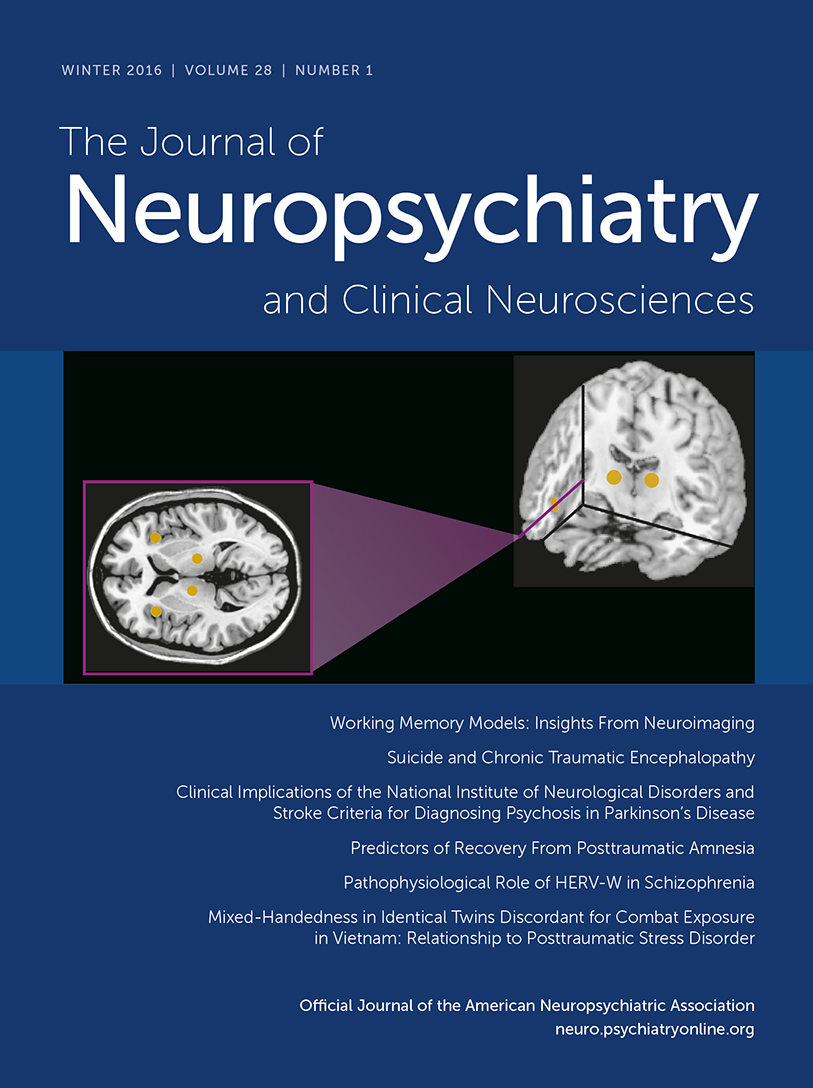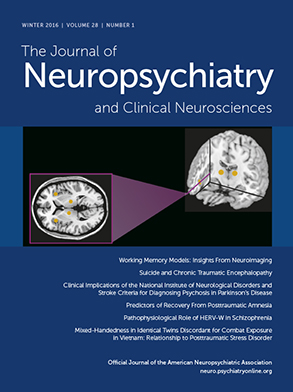To the Editor: Currently, there are no established guidelines on how to approach the differential diagnosis of catatonia in a patient with neuropsychiatric systemic lupus erythematosus (NPSLE). Patients with SLE commonly experience neuropsychiatric manifestations, although prevalence estimates have varied widely (12%−95%).
1 In 1999, the American College of Rheumatologists (ACR) developed a standardized nomenclature for the manifestations of NPSLE based on expert consensus with the purpose of improving the reproducibility of diagnoses and study comparability.
2 However, catatonia was not included as a recognized syndrome. Furthermore, recommendations as to the indications and frequency of ECT in patients with NPSLE are lacking. We present a case of severe malignant catatonia in a patient with NPSLE refractory to high-dose benzodiazepines and immunosuppressants that dramatically improved with daily ECT.
Case Report
The patient is a 19-year-old female college student with a 2-year history of SLE and Raynaud’s phenomenon and no psychiatric history, presenting with a 2-week history of insomnia, hyperactivity, and auditory hallucinations. Before this first hospitalization, she had presented to the outpatient rheumatology clinic with elevated antinuclear, anti-Smith, antiribonuclear protein, and anti-Ro antibodies. The patient had not been taking hydroxychloroquine and mycophenolate mofetil for the last 2 months as recommended by rheumatology. In the emergency room, she exhibited disorientation, hyperverbality, and agitation requiring intramuscular haloperidol. She also exhibited catatonic features such as staring, posturing, and gegenhalten, which were present before the administration of the antipsychotic. Workup was significant for reduced complement levels and leukopenia. Neurological examination, CSF analysis, MR imaging scan, and EEG did not demonstrate any abnormalities. Of note, her serum was negative for antiribosomal P, anti-dsDNA, and anti-N-methyl-d-aspartic acid receptor antibodies. Her mental status improved after receiving a 3-day course of intravenous methylprednisolone. She was discharged home with sertraline 25 mg daily for depressed mood, and she also received oral prednisone. However, she missed a planned outpatient cyclophosphamide infusion.
At 7 days after hospital discharge, she returned to the emergency room with a 1-day history of fluctuating arousal and tangentiality. She exhibited tachycardia at 108 beats/min and hypertension at 187/124 mm Hg. She exhibited variable mitmachen in her right upper extremity with no other features of catatonia. Neurological examination, repeated CSF analysis, MR imaging scans, and EEG again did not demonstrate any abnormalities, although she still exhibited mild leukopenia and hypocomplementemia. Sertraline was discontinued, and she received pulse methylprednisolone, hydroxychloroquine, and a cyclophosphamide infusion as an inpatient. She became progressively catatonic by hospital day 4, with posturing, severe echolalia, and verbigeration. She was given scheduled intravenous lorazepam with dose escalations up to 24 mg/day. On hospital day 7, she experienced tachypnea at 40 breaths/min, requiring mechanical ventilation. She was transferred to the intensive care unit (ICU) and was prescribed midazolam and esmolol drips. The midazolam drip was increased to up to 15 mg/hour, and she received three plasma exchanges. Despite receiving high-dose benzodiazepines and a total of four different immunosuppressants, she continued to exhibit severe rigidity, catalepsy, and complete mutism.
Bilateral ECT was initiated on an emergency basis on hospital day 12 in response to escalating tachycardia, hypertension, and fevers. Attempts to discontinue benzodiazepines before initiation of ECT were unsuccessful because of acute vital sign destabilization. She was administered flumazenil before the procedure, and ketamine was used as the induction agent to lower seizure threshold. She was also hyperventilated and administered esmolol as needed before stimulus initiation. She received seven daily bilateral ECT treatments in the ICU, which led to such improvement that she no longer required benzodiazepines or antihypertensive drugs and was extubated. She received three additional plasma exchanges before being transferred out of the ICU. ECT was tapered to three times per week and then weekly, and she completed a course of intensive physical therapy. On hospital day 30, she exhibited no signs of catatonia, and she was discharged with oral prednisone and hydroxychloroquine. She received five additional ECT treatments as an outpatient for a total 17 treatments. She remained free of catatonic signs 5 months after hospital discharge.
Discussion
This case demonstrates how malignant catatonia can be a life-threatening complication of NPSLE. The patient's presentation could have been defined as psychosis in the context of an acute confusional state.
2 The diagnosis of manic delirium may have better accounted for the patient’s fluctuating arousal, psychosis, insomnia, and hyperactivity. Catatonia can be a prominent feature of this syndrome, which requires prompt recognition and appropriate treatment with benzodiazepines to prevent progression to malignant catatonia.
3 The patient's exposure to haloperidol and sertraline may have increased the risk for the development of malignant catatonia,
4 but these drugs were less likely to be the inciting agents given the presence of delirium and catatonic signs before their administration. The diagnosis of steroid-induced psychosis and catatonia was also unlikely given the laboratory evidence of a lupus flare, the presence of catatonic signs before steroid administration, and resolution of catatonic signs with immunosuppressant therapy during the initial hospitalization. Although imaging did not demonstrate any abnormalities, MR imaging scan results have been reported to be normal in 42% of patients with NPSLE.
5The evidence base guiding the treatment of catatonia in NPSLE consists of case reports. A meta-analysis suggesting greater benefit from cyclophosphamide versus methylprednisolone for NPSLE included only one randomized control trial, and none of the patients in the study had acute confusional state, psychosis, or catatonia.
6,7 A previous review of the literature demonstrated that patients were commonly treated with immunosuppressants and/or benzodiazepines, with more patients with refractory disease additionally receiving ECT.
8 Furthermore, our literature review of the evidence for the potential benefit of daily ECT produced one retrospective chart review of 27 patients with catatonia.
9 van Waarde et al.
9 reported greater improvement in younger patients with dysautonomia and in patients who received daily ECT in the first week of treatment. We hope to increase awareness of the potential benefit of ECT in cases of patients with NPSLE with severe malignant catatonia and to renew interest in studying optimal treatment schedules in catatonic patients with refractory dysautonomia.

